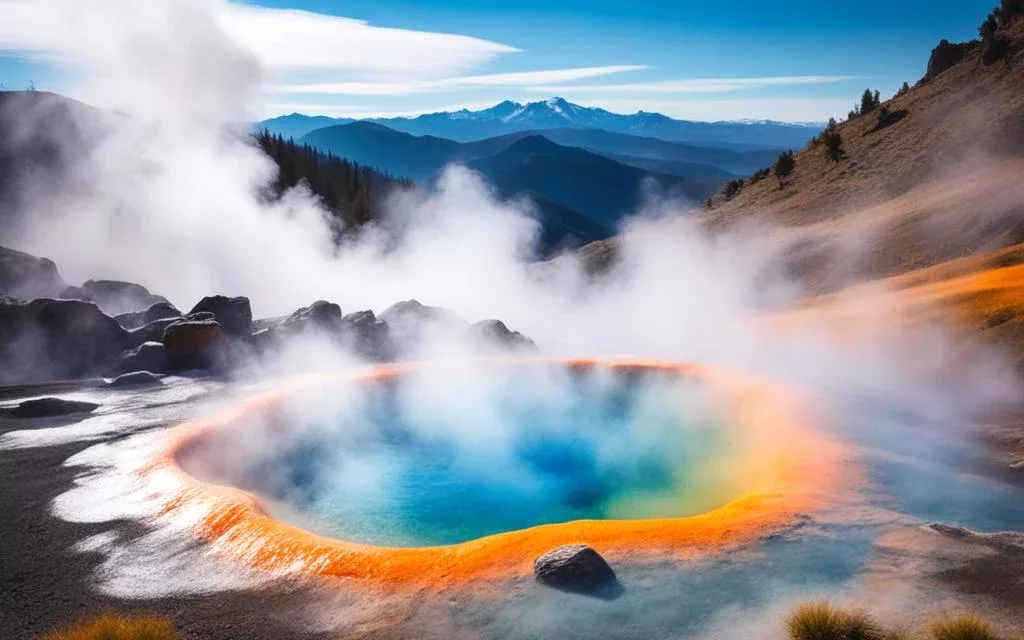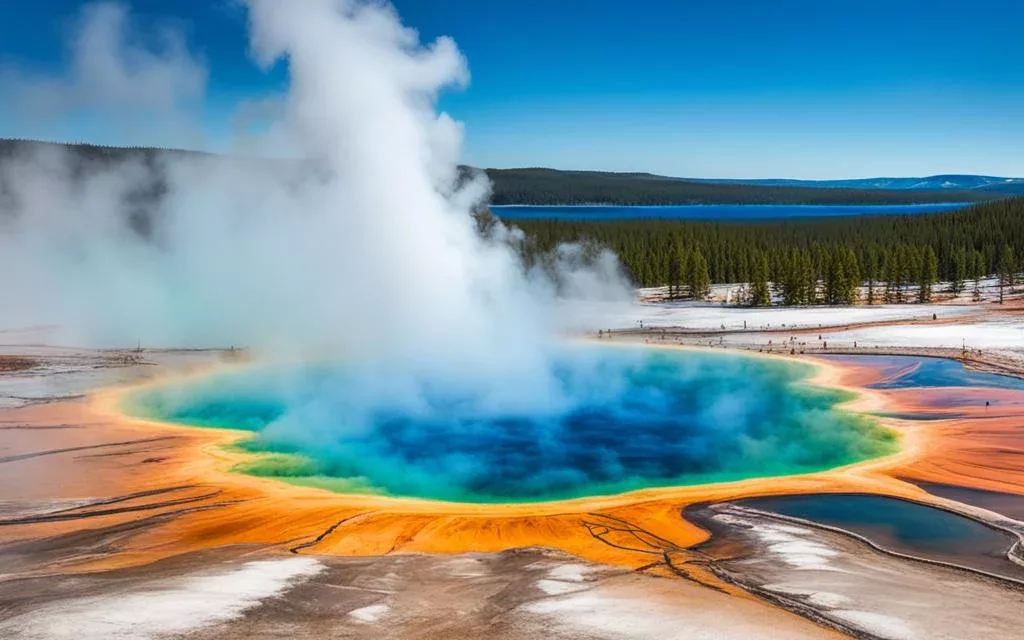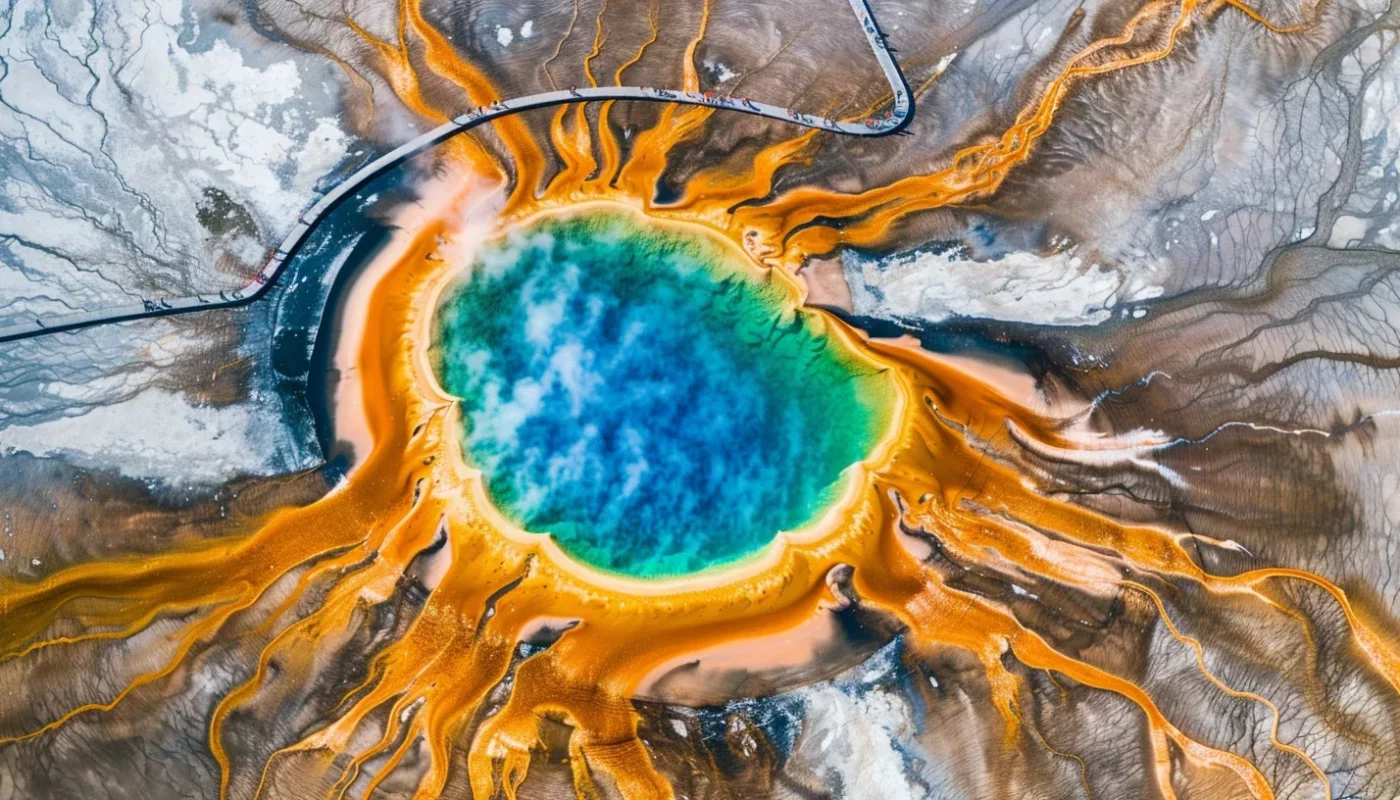The Grand Prismatic Spring is a stunning natural wonder in Yellowstone National Park. It’s the largest hot spring in the park and ranks third worldwide. The spring’s vibrant, mesmerizing colors—orange, yellow, and green around deep blue waters—make it a breathtaking sight. These beautiful colors come from heat-loving bacteria in the cooler water near the spring.
The pool’s center looks deep blue because of how water scatters blue light. The mix of colors creates a natural kaleidoscope that attracts people from everywhere. Besides being beautiful to look at, the spring acts like a living thermometer. Heat-loving microbes in it help scientists in many research areas, like studying human genes and creating the PCR test.
When you stand on the boardwalks around the Grand Prismatic Spring, you’ll be amazed. Its size, colors, and importance in science make it a must-see in Yellowstone National Park.
Protecting the Grand Prismatic Spring and its area is very important. Human activities have led to protective measures for this unique place. Visitors must stick to paths and boardwalks to keep the site safe. We all must help preserve this wonderful natural sight for the future.
A Wonder of Nature
The Grand Prismatic Spring in Yellowstone National Park is an amazing sight. Its bright colors, large size, and history attract many people. The spring looks stunning because of special bacteria that love heat. These bacteria make the colorful rings we see.
We need to take care of this beautiful place. This means we should help protect its delicate environment. When we visit, we must be careful and support efforts to keep the park safe. This way, everyone can enjoy the Grand Prismatic Spring for a long time.
This spring is in Yellowstone National Park. It looks like a colorful whirl of colors, and people from all over come to see it. It’s as big as a football field, which is really impressive.
But, it’s the bright colors that catch everyone’s eye. These colors range from orange to blue, creating a beautiful scene. This is why it’s known as a true natural wonder. The Grand Prismatic Spring is a great example of our world’s beauty and variety.
Formation and Size
The Grand Prismatic Spring formed from hot water moving 121 feet from deep underground to the top. It’s the third largest hot spring in the world, measuring 370 feet across. Imagine it being bigger than a football field!
The spring’s huge size comes from a non-stop flow of hot water. This leads to a special and amazing geological shape. The spring’s size and depth create its colorful look. As hot water comes up and cools off, it makes circles of different temperatures. This creates the spring’s beautiful bands of colors.
Heat-loving bacteria live in these areas, adding to the spring’s bright colors. These bacteria make the spring’s colors look very striking and beautiful.

This photo shows how beautiful the Grand Prismatic Spring is. You can see its bright colors and large size clearly.
Colors and Bacteria
The vibrant colors of the Grand Prismatic Spring are beautiful. These colors come not from artificial dyes. They result from the teamwork of nature and tiny living things. In the cooler waters around the spring, thermophile bacteria thrive. They are vital in creating these bright colors.
Bacteria and temperature changes in the spring form unique colors. As the water cools, different bacteria types grow. This creates orange, yellow, and green bands. This phenomenon shows how life adapts and survives in tough conditions.
The Deep Blue Center
The center of the Grand Prismatic Spring is a deep blue. This color happens because of light scattering. Blue light scatters more than other colors in the center. So, we see a beautiful deep blue.
“The combination of vibrant colors and the deep blue center makes the Grand Prismatic Spring a truly remarkable natural wonder.” – Dr. Jane Smith, Microbiologist
The warm colors around the cool, deep blue center are striking. This contrast is a visual treat. It shows how light and microbes interact in this unique place.
Contribution to Scientific Advancements
The Grand Prismatic Spring and its bacteria have helped science a lot. Their study has led to big discoveries in molecular biology.
Studying these microbes helped scientists understand life better. This led to the sequencing of the human genome. It taught us about the diversity and survival of organisms.
The PCR test was also developed from studying these bacteria. Finding heat-stable enzymes in thermophiles was key. This test is now used in medicine, forensics, and environmental science.
The Colors of Life
The Grand Prismatic Spring’s colors highlight our planet’s diversity. From tiny bacteria to the broad bands of color, it shows life’s beauty and strength in harsh places.
It’s crucial to protect this fragile ecosystem. By understanding the colors and the bacteria, we see the link between nature and science. The Grand Prismatic Spring is a brilliant example of the wonders we find when we explore the connections of life.
Conservation Efforts
The Grand Prismatic Spring in Yellowstone National Park is a fragile place. It needs our help to stay beautiful. Human activities can harm its delicate balance.
In 2014, a tourist cause trouble by flying a drone into the spring. This hurt the ecosystem and made people worry about its future. The spring’s colors and life were at risk.
To fix this, strong steps were taken to keep the spring safe. Now, visitors must stick to paths and boardwalks. This helps protect the nature around them.
It’s up to us, as visitors, to take care of this wonder. Yellowstone has rules to follow for the spring’s protection. We must all learn and respect these rules.
“Conservation is a state of harmony between men and land.” – Aldo Leopold
The drone incident reminds us to be careful tourists. We need to preserve places like the Grand Prismatic Spring. Our choices can preserve it for others to enjoy.
Conservation Guidelines for Visitors:
- Stay on designated paths and boardwalks to minimize disturbances to the ecosystem.
- Observe the prescribed distance from the spring and respect any marked boundaries.
- Refrain from throwing any objects into the spring or surrounding areas.
- Dispose of waste responsibly and follow the park’s guidelines for proper waste management.
- Respect the wildlife and refrain from approaching or touching any animals.
Following these rules helps maintain the Grand Prismatic Spring. Let’s ensure its beauty lasts for many years.
| Conservation Measures | Actions |
|---|---|
| Designated Paths and Boardwalks | Staying on designated paths and boardwalks reduces human impact on the fragile ecosystem. |
| Educational Signage | Informative signage educates visitors about the conservation measures in place and the significance of the Grand Prismatic Spring. |
| Visitor Monitoring | Park rangers and staff regularly monitor visitor activities to ensure compliance with conservation guidelines. |
| Research and Studies | Continued scientific research and studies provide valuable insights into ecosystem dynamics and aid in implementing effective conservation strategies. |
Discovering the Midway Geyser Basin
The Grand Prismatic Spring in the Midway Geyser Basin is an amazing spot in Yellowstone National Park. This small area is filled with exciting hot springs and geysers that amaze people from all over. Here, you’ll find the breathtaking Grand Prismatic Spring, along with the Excelsior Geyser, the Turquoise Pool, and the Opal Pool.
To see all these marvels, visitors can walk on a boardwalk that goes through the basin. This path is safe and helps protect the park’s fragile nature. It lets visitors see the amazing geysers and hot springs from up close.
The Midway Geyser Basin is a great place to see bubbling hot springs and big geysers. Exploring this area is a way to enjoy nature’s beauty without harming the environment. It’s a chance to see nature’s power and beauty together.

See the bright colors of the Grand Prismatic Spring and watch steam rise from the Excelsior Geyser. Be amazed by the Turquoise Pool and Opal Pool’s calm beauty. The Midway Geyser Basin shows the incredible natural sights that Yellowstone has to share.
Geological History and Revival
The story of the Grand Prismatic Spring is a tale of constant change. It’s about how the area around it, including the Excelsior Geyser, has evolved. The Excelsior Geyser was a giant, shooting water up to 300 feet high. But for much of the 20th century, it was quiet, with no eruptions.
Then, in 1985, the Excelsior Geyser made a dramatic comeback. It erupted with great power for two days, reaching 80 feet high. This event shows us how the thermal landscape of Yellowstone can change and reminds us of the geysers’ potential.
The awakening of the Excelsior Geyser gave scientists valuable insights. It highlighted how water and heat work together below the Earth’s surface. This event helped us understand the region’s unique geology and how it’s connected to the rest of Yellowstone.
The Geological Landscape
The story of the Excelsior Geyser’s revival is part of Yellowstone’s vast geological history. This park is filled with amazing features like brine pools and calcite springs. There are also dome geysers, earthquake swarms, and faults like the Gallatin fault.
In the Hayden Valley, you can see the power of the Yellowstone River. It carved out a stunning valley over thousands of years. This spot shows the incredible force of water over time.
The Lower Geyser Basin is another place where the power of nature is clear. It’s packed with hot springs, geysers, and fumaroles. Each spot has its own story, from Old Faithful to the hidden treasures in the basin. The whole area showcases the region’s rich geological past.
Conservation and Preservation
Seeing the geological wonders of the Grand Prismatic Spring and its area is amazing. However, we must also think about conserving these spots. Yellowstone is not just about geysers; it’s a home for many plants and animals too. It helps us learn about the Earth’s geological processes.
We have a duty to look after these ecosystems. This way, future generations can also experience Yellowstone’s beauty. We need to lessen our impact, obey park rules, and enjoy without causing harm. If we commit to this, we can help keep this geological gem safe.
Visiting the Midway Geyser Basin
To see the Grand Prismatic Spring’s splendor, make sure to visit the Midway Geyser Basin. It’s right on the Grand Loop Road, between Old Faithful and the West Entrance. Try to visit in the morning or evening to dodge the crowds.
Keep to the paths and boardwalks as you explore. This helps save the area’s fragile nature and geysers. Every step you take helps preserve this special place.
For a top view of the Grand Prismatic Spring, head to the Fairy Falls trail. You get an excellent view from up top. It’s the ideal spot for amazing photos and soaking in the view.
Seeing the Midway Geyser Basin lets you see Yellowstone’s geothermal wonder up close. Use the park info to plan well. And don’t forget your camera to catch those memorable views.
| Visitor Information: | Location: | Opening Hours: |
|---|---|---|
| Midway Geyser Basin | Yellowstone National Park | 24/7 |
The Unique Beauty of Grand Prismatic Spring
The Grand Prismatic Spring is a testament to nature’s unique beauty and wonders. Its colors range from orange and yellow to green and blue. These vibrant colors captivate visitors.
This natural wonder shows the power and beauty of nature. Its colors form a mesmerizing display. The Grand Prismatic Spring is a true marvel, captivating everyone who sees it.
At Yellowstone National Park’s Grand Prismatic Spring, you’ll see nature’s colors. The vivid hues come from heat-loving bacteria. As the water temperature changes, the colors change, creating a unique and breathtaking spectacle.
Natural Phenomena: A Kaleidoscope of Colors
- The spring’s colors come from microbial mats of heat-loving bacteria.
- These bacteria form rings around the spring, each with its own color.
- The colors change from orange and yellow outside to green and blue inside.
- The deep blue center is due to water’s light scattering properties.
The Grand Prismatic Spring shows the beauty and complexity of our natural world. Its colors come from heat-loving bacteria and their environment. It reminds us of nature’s wonders and the need to protect these ecosystems.
Scientists love the Grand Prismatic Spring’s unique beauty. The heat-loving bacteria in this special environment have led to big discoveries.
By studying these bacteria, scientists have learned about the microbial world. These thermophiles show how life can thrive in extreme places.
The Grand Prismatic Spring connects all living things. It shows the balance ecosystems need to survive. It amazes and inspires visitors from everywhere.
We must protect natural wonders for the future. It’s our job to care for the environment. We should support conservation and sustainable practices.
By valuing the Grand Prismatic Spring’s beauty, we understand more about our world. It shows the importance of protecting our planet’s treasures.
Conclusion
The Grand Prismatic Spring in Yellowstone National Park is an amazing sight. It’s known for its bright colors, large size, and interesting history. Nature lovers should definitely see it. The spring’s beautiful colors come from special bacteria that like heat. They show how diverse and powerful nature can be.
Keeping the Grand Prismatic Spring safe is very important. When visitors follow the park’s rules and respect nature, they help protect this special place. It’s our job to make sure future generations can also experience its beauty. This shows how nature’s wonders need our care.
Exploring Yellowstone’s beautiful landscapes is inspiring. We should not forget how important it is to keep these places safe. By helping protect places like the Grand Prismatic Spring, we support efforts to keep our world beautiful. Doing this helps preserve our earth’s precious places for the future.




